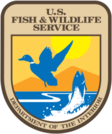United States Fish and Wildlife Service: Difference between revisions
mNo edit summary |
mNo edit summary |
||
| Line 1: | Line 1: | ||
<div class="irlbody"> | <div class="irlbody"> | ||
{{IRL header}} | {{IRL header estuary|cat}} | ||
<p class="irlsubtitle">Work with others to conserve, protect and enhance fish, wildlife and plants and their habitats for the continuing benefit of the American people.</p> | <p class="irlsubtitle">Work with others to conserve, protect and enhance fish, wildlife and plants and their habitats for the continuing benefit of the American people.</p> | ||
<div class="irlcontent"> | <div class="irlcontent"> | ||
| Line 60: | Line 60: | ||
<references /> | <references /> | ||
</div> | </div> | ||
{{IRL footer}} | {{IRL footer estuary|cat=United States Government}} | ||
</div> | </div> | ||
[[Category:U.S. Fish and Wildlife Service]] | [[Category:U.S. Fish and Wildlife Service]] | ||
Revision as of 08:05, November 8, 2020
Work with others to conserve, protect and enhance fish, wildlife and plants and their habitats for the continuing benefit of the American people.
About the FWS
The U.S. Fish and Wildlife Service (FWS), a bureau within the United States Department of the Interior, is America’s principal conservation agency within the Executive Branch of U.S. government. The FWS is the primary federal agency responsible for the conservation, protection, and enhancement of the America’s fish and wildlife populations and their habitats.
Although the FWS shares some conservation responsibilities with other federal, state, tribal, local, and private entities, it has specific trustee obligations for migratory birds, threatened and endangered species, anadromous fish, and certain marine mammals. As part of its mission, the Service administers the National Wildlife Refuge System, a national network of lands and waters established for the management and protection of these resources.[1]
History
Fish and Wildlife Service programs are among the oldest in the world dedicated to natural resource conservation. You can trace their history back to 1871 and the U.S. Commission on Fish and Fisheries in the Department of Commerce and the Division of Economic Ornithology and Mammalogy in the Department of Agriculture
A 1940 reorganization plan (54 Stat. 1232) in the Department of the Interior consolidated the Bureau of Fisheries and the Bureau of Biological Survey into one agency to be known as the Fish and Wildlife Service. The Bureau of Sport Fisheries and Wildlife was created as a part of the U.S. Fish and Wildlife Service in the Department of the Interior on November 6, 1956, by the Fish and Wildlife Act of 1956 (70 Stat. 1119). That act was amended on July 1, 1974, by Public Law 93-271 (88 Stat. 92) to, among other purposes, abolish the position of Commissioner of Fish and Wildlife and designate the Bureau as the U.S. Fish and Wildlife Service.[2]
The first employee of the National Refuge System was Paul Kroegel, a Sebastian, Florida resident who fought to stop the slaughter of Brown pelicans in the Indian River lagoon. His efforts convinced Theodore Roosevelt to designate Pelican Island as our nation's first wildlife refuge in 1903.[3]
Mission
Work with others to conserve, protect and enhance fish, wildlife and plants and their habitats for the continuing benefit of the American people.
Vision
Together, we will connect lands and waters to sustain fish, wildlife and plants by being visionary leaders, bold innovators and trusted partners, working with and for people.
Objective
The objective of the Fish and Wildlife Service is to:
- Assist in the development and application of an environmental stewardship ethic for our society, based on ecological principles, scientific knowledge of fish and wildlife, and a sense of moral responsibility.
- Guide the conservation, development, and management of the Nation's fish and wildlife resources.
- Administer a national program to provide the public opportunities to understand, appreciate, and wisely use fish and wildlife resources.
Functions
The primary functions of the FWS are:
- Enforce federal wildlife laws,
- Protect endangered species,
- Manage migratory birds,
- Restore nationally significant fisheries,
- Conserve and restore wildlife habitat such as wetlands,
- Help foreign governments with their international conservation efforts, and
- Distribute hundreds of millions of dollars, through our Wildlife Sport Fish and Restoration program, in excise taxes on fishing and hunting equipment to State fish and wildlife agencies.
Resources
The FWS manages the National Wildlife Refuge System with more than 560 National Wildlife Refuges as well as small wetlands and other special management areas encompassing more than 150 million acres. Under the Fisheries program they also operate over 70 National Fish Hatcheries and 65 fishery resource offices. The Ecological Services program has 86 field stations across all 50 states.[1]
The vast majority of fish and wildlife habitat is on non-federal lands. Voluntary habitat protection and restoration programs like the Partners for Fish and Wildlife Program and the Coastal Program and other partnership programs are the primary ways FWS delivers habitat conservation on public and private lands.
The Service employs approximately 9,000 people at facilities across the United States. The FWS is a decentralized organization with headquarters in Washington, D.C. and regional offices across the country. FWS Southeast Region manages the National Wildlife Refuge areas and field offices in Florida.


